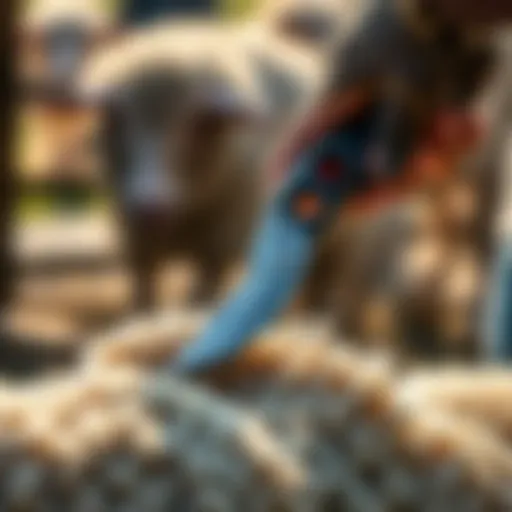Understanding 5000K LED Bulbs for Horticulture
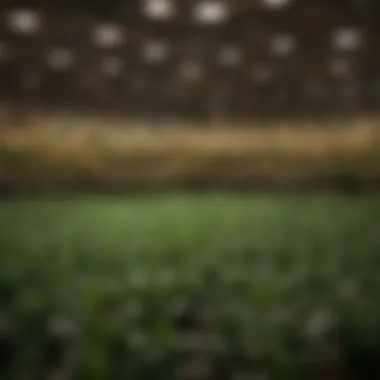

Intro
In recent years, agricultural practices have witnessed a significant metamorphosis. At the heart of this transformation lies innovative lighting technologies, particularly the utilization of 5000K LED bulbs. These bulbs have emerged as a game changer for farmers and horticulturists, offering energy efficiency and promoting sustainable practices that align well with modern environmental standards. Understanding the ins and outs of these lighting solutions can be critical for anyone looking to boost plant growth effectively while minimizing their ecological footprint.
With a color temperature of 5000 Kelvin, these bulbs emit a bright, white light that closely replicates natural daylight. This feature is essential, as it fosters photosynthesis, driving healthier and more productive plants. As we dive deeper into the role of 5000K LED bulbs, we will explore their significance, the technology underpinning them, the advantages they present, and how they stack up against traditional lighting options.
With that, let’s delve into the Latest Trends in Agriculture, where we’ll look closely at how the lighting solutions are reshaping farming practices.
Prelude to LED Technology
The ever-evolving field of horticulture increasingly turns its focus to the potential of LED technology. This interest stems from a desire not only to improve plant growth conditions but also to embrace sustainability within agricultural practices. The application of light emitting diodes, or LEDs, represents a significant advancement over traditional forms of lighting. Understanding how LEDs work and their benefits in gardening or farming can be crucial for anyone looking to optimize their plant growth.
Understanding Light Emitting Diodes
Light emitting diodes are an innovative piece of technology that harness electricity to produce light. This differs fundamentally from incandescent or fluorescent bulbs, which rely on heating a filament or gas discharge, respectively. LEDs function through a semiconductor that emits light when an electric current passes through it. One of the essential characteristics of LEDs lies in their ability to produce specific wavelengths. This makes them particularly useful for horticultural applications, as various plants respond best to particular parts of the light spectrum.
For instance, a 5000K LED bulb offers a color temperature that mimics daylight, delivering a balance that supports photosynthesis and optimal plant growth. It can be likened to a meticulous painter who selects just the right colors for their canvas. The clarity and precision with which LEDs can produce these wavelengths facilitate growth in plants far more efficiently than traditional lighting methods.
Benefits Over Traditional Lighting
The advantages of using 5000K LED bulbs in horticulture are numerous and encompass several key areas:
- Energy Efficiency: LEDs consume significantly less power compared to incandescents and fluorescents, which translates to lower electricity bills. It’s like choosing a fuel-efficient car instead of a gas guzzler.
- Longevity: The lifespan of LED bulbs tends to be much longer, lasting up to 50,000 hours or more. Unlike traditional bulbs, which might flicker out just when you need them most, LEDs maintain consistent performance over time.
- Lower Heat Output: LEDs generate less heat while producing light. They won't bake your plants under a hot sun; instead, they offer a gentler warmth that helps maintain optimal growing conditions.
- Flexibility in Placement: Thanks to the directional nature of LEDs, growers can place them closer to plants without fear of burning them. This targeted approach ensures plants receive more light exactly where it matters most.
"Switching to LED technology is like upgrading from a horse-drawn carriage to a high-speed train. The benefits are enormous, and the impact on efficiency is undeniable."
Investing in LED technology is not just a trend; it's a shift towards a more efficient and sustainable approach to gardening and agriculture. As horticulturists and farmers appreciate the myriad advantages offered by LEDs, the commitment to employing such technology will likely deepen, paving the way for a future where plant growth is smarter, greener, and more effective than ever.
What are 5000K LED Bulbs?
In the evolving landscape of horticulture, understanding the specifics of 5000K LED bulbs is crucial for anyone looking to optimize plant growth. These bulbs don’t just shed light; they offer a full-spectrum approach that aligns closely with the needs of various plants. Their color temperature, measured in Kelvin (K), represents the character of light emitted. When it comes to 5000K LED bulbs, the warm yet crisp light simulates the natural daylight that plants thrive under. This section aims to unpack the core elements that characterize these bulbs, looking closely at their advantages and the considerations that come into play.
Defining Color Temperature
Color temperature is a vital concept in horticulture, primarily because it informs us how light affects plant behaviors such as photosynthesis. When we talk about 5000K, we refer to a light hue that appears white, akin to a clear blue sky at high noon.
- Cooler temperatures (e.g., 3000K) produce more yellow or orange light, while 5000K emits a balanced, bright light that leans slightly towards blue. This blue component is especially beneficial during the vegetative stage of plant growth, helping to encourage lush foliage and robust structure.
- The higher the K value, the closer the light resembles daylight, which is what most plants naturally react to. Hence, using 5000K bulbs can create an environment that mimics their typical outdoor conditions, leading to healthier and more productive plants.
Spectrum and Plant Growth
The light spectrum emitted by 5000K LED bulbs includes wavelengths that are pivotal for various physiological processes in plants. Here’s a deeper look:
- Photosynthesis: Chlorophyll absorbs light primarily in the blue (400-500nm) and red (600-700nm) ranges. With 5000K bulbs, the balance between these wavelengths promotes effective photosynthesis, resulting in vigorous plant growth.
- Stomatal Opening: The full-spectrum light can also influence stomatal behavior. Plants open their stomata to facilitate gas exchange in brighter light conditions, which allows for higher rates of photosynthesis and transpiration.
- Duty Cycle: Plants also respond to light duration, known as photoperiodism. Utilizing 5000K LED lights can better manage the duty cycle for different species, optimizing growth phases from germination to flowering.
In summary, 5000K LED bulbs serve an integral role in horticulture, shining brightly not only on their energy efficiency but also on the direct benefits to plant health and productivity. As farmers and enthusiasts delve deeper into these aspects, it becomes clear that these bulbs are not just a passing trend; they are a fundamental tool for sustainable agriculture and productive farming.
Energy Efficiency of 5000K LED Bulbs
In the realm of modern horticulture, the energy efficiency of 5000K LED bulbs cannot be overstated. These bulbs represent a significant leap from traditional lighting, demonstrating not just their power to illuminate but also their capacity to drastically reduce energy consumption. Using energy-efficient lighting is not merely an economic decision; it’s a step towards sustainable agricultural practices that benefit both the environment and the bottom line.
Comparison with Incandescent and Fluorescent Lights
When you stack 5000K LED bulbs against older incandescent and fluorescent varieties, the advantages become glaringly apparent.
- Energy Consumption: Incandescent bulbs typically operate at around 60 to 100 watts and convert only about 10% of their energy into usable light, with the rest lost as heat. Fluorescent bulbs, while a bit more efficient, still consume significantly more energy than their LED counterparts, which might only use about 10 to 20 watts for similar light output.
- Brightness: In terms of lumens per watt, LEDs often provide more brightness with less energy. For example, a 5000K LED bulb can produce about 90-100 lumens per watt, while an incandescent may only produce about 15 lumens per watt.
- Heat Production: With incandescent bulbs, gardeners often notice that heat management becomes an issue, especially in confined growing spaces. LEDs produce considerably less heat. This not only helps maintain the ideal temperature for plant growth but also reduces the need for additional cooling systems.
This efficiency means that growers can lighten their energy load significantly, leading to lower electricity bills and a reduced environmental footprint. It’s a win-win situation in any horticultural setting.
Longevity and Cost-Effectiveness
The longevity of 5000K LED bulbs further enhances their appeal in horticultural applications. Unlike traditional bulbs, which often need replacing every few months, LEDs can last for years, some even up to 25,000 hours or more, depending on usage. This extended lifespan can lead to substantial savings over time.
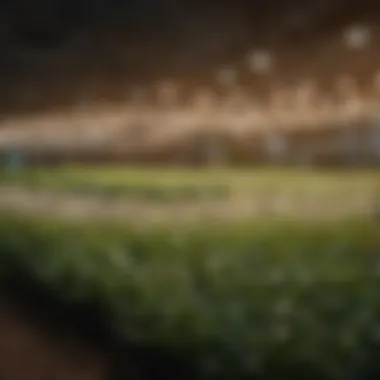

- Replacement Frequency: Fewer replacements mean less hassle and lower expenses related to buying new bulbs and labor costs for installation.
- Energy Savings Over Time: While the initial cost of 5000K LED bulbs might be higher than that of incandescent or fluorescent lights, the cumulative savings on energy bills often pays back the initial investment within a year or two. The durability of LEDs ensures that their advantages compound, yielding even greater savings over their lifespan.
"Investing in 5000K LED technology is akin to planting seeds for a greener future, where both your plants and your budget flourish."
By embracing 5000K LED bulbs, farmers and horticulture enthusiasts are not just choosing a product; they are opting for a smarter, more sustainable, and financially sound solution for their lighting needs.
Application in Horticulture
The application of 5000K LED bulbs in horticulture holds significant importance due to their ability to facilitate various aspects of plant growth and development. Whether it's in a controlled indoor environment or an expansive outdoor setting, these bulbs play a crucial role in maximizing productivity while maintaining sustainability. With the increasing focus on environmental impact and energy efficiency, understanding how to use these bulbs effectively can lead to better agricultural practices.
Indoor vs. Outdoor Usage
When we talk about indoor horticulture, using 5000K LED bulbs shines brightly as a game changer. In a world where space can be at a premium, these bulbs provide the right color temperature to stimulate growth even when natural light is sparse. They mimic daylight effectively, creating an environment where plants can thrive year-round regardless of the season outside. For instance, they can be crucial for those growing plants like basil or tomatoes indoors. A grower can align the placement of these bulbs to ensure that every inch of available space gets the light needed.
On the flip side, outdoor usage of 5000K LED bulbs may seem counterintuitive at first glance, as sunlight is abundant. However, many agricultural practitioners recognize that during the early mornings or late afternoons, when shadows begin to rise, these bulbs can provide the necessary boost in light intensity. This ensures that crops like lettuce or spinach can continue absorbing sufficient light for steady growth when the sunlight might not be as strong. There’s also a benefit in protecting crops when weather conditions turn overcast, helping to prevent stunted growth.
"In essence, the right lighting translates directly to better yields and healthier plants."
Integration with Hydroponics and Aquaponics Systems
In the realm of modern agriculture, the fusion of 5000K LED bulbs with hydroponics and aquaponics systems is a particularly enticing topic. Both methods of cultivating plants without soil rely heavily on a controlled environment. Here, these bulbs prove invaluable. They've been found to enhance photosynthesis, leading to faster grow times and more vigorous plants due to their ideal spectrum.
- Energy Efficiency: 5000K LEDs consume less energy compared to other lighting solutions, making them perfect for hydroponics setups which require consistent lighting to facilitate growth cycles.
- Space Optimization: As these systems often operate in limited spaces, the low heat emissions ensure that plants aren’t scorched, allowing growers to stack or position plants closely together.
- Customizable Light Conditions: Within aquaponics systems, integrating these LED bulbs allows for tailored light conditions suited to different plants. For instance, leafy greens might fare better under specific light conditions compared to fruiting plants like bell peppers.
Overall, the integration of 5000K LED bulbs into these types of systems is a testament to their adaptability and efficiency, allowing for a more sustainable agricultural practice. As more growers become aware of the benefits of LED technology, the trend may well shift towards greater adoption in both home and professional setups.
Benefits of 5000K LED Bulbs for Plants
Understanding the benefits of 5000K LED bulbs for plants is crucial in today’s horticultural practices. As the agricultural world increasingly gravitates towards efficient and sustainable solutions, these bulbs have emerged as a standout lighting option. Not only do they enhance plant growth, but they also align well with the goals of energy efficiency and environmental responsibility. This section seeks to elucidate the specific advantages that these bulbs bring to the table, particularly in optimizing growth outcomes for various plant species.
Enhanced Photosynthesis
Light plays a fundamental role in the process of photosynthesis, which is the lifeblood of plant growth. 5000K LED bulbs emit a light spectrum that closely resembles natural daylight. This spectrum is rich in blue wavelengths, which are particularly effective at driving photosynthesis. Animal instinct to reach for the sunlight is mirrored in plants—they, too, thrive on light that mimics natural daylight.
- High Blue Light Proportion: The abundant blue light aids in chlorophyll production, which is essential for converting sunlight into energy. Studies have shown that when plants receive light in the blue spectrum, such as from a 5000K bulb, they not only grow more robustly, but also exhibit healthier foliage.
- Clarity in Light Intensity: With 5000K LED lights, plants can receive a consistent intensity of light. This consistency ensures that plants can conduct photosynthesis effectively throughout their growth cycles, regardless of external lighting conditions.
"Using 5000K LED lights can be a game changer for indoor gardeners who aim for that lush green look. It’s like giving plants their own personal sun!"
Improved Growth Rates
When plants enjoy the right light conditions, growth rates can significantly improve. 5000K LED bulbs facilitate a more rapid and consistent growth trajectory.
- Shorter Growth Cycles: Research indicates that plants exposed to optimal light conditions tend to mature faster, leading to shorter growth cycles. This not only allows for quicker harvests but also maximizes the use of space in controlled environments.
- Stronger Root Development: Plants under 5000K LED lights also develop stronger root systems. A robust root system is vital for nutrient uptake, leading to healthier, more resilient plants capable of withstanding various stresses.
In summary, the benefits of 5000K LED bulbs for plants extend beyond just energy savings; they create an optimal environment for photosynthesis and growth, ensuring that cultivators can achieve their desired outcomes in an eco-friendly manner. As agriculture practices evolve, embracing such efficient technologies is no longer a luxury, but a necessity.
Considerations When Choosing Bulbs
When it comes to selecting the right bulb for your horticultural needs, understanding the key considerations can make all the difference. The right choice can enhance plant growth, maximize energy efficiency, and minimize costs over time. In this section, we’ll dive into two crucial factors: lumens and watts, and durability and environmental considerations. Picking the correct bulb is more than just a matter of brightness or wattage; it’s about creating an optimal environment for your plants to thrive.
Understanding Lumens and Watts
To navigate the labyrinth of light bulbs, one must grasp a couple of concepts: lumens and watts. Lumens measure how much light a bulb emits; the higher the lumens, the brighter the bulb. This is critical when you’re looking to provide adequate light for plant growth. For instance, while a 1000-lumen 5000K LED bulb can produce a strong light comparable to a traditional incandescent bulb, it uses much less energy.
On the other hand, watts tell you how much energy the bulb consumes. When you choose a bulb, you’ll want to strike a balance. A bulb with high lumens but low watts brings efficiency to the table, providing ample light without sending your electric bill through the roof. Consider also the type of plants you’re growing. For instance, leafy greens may thrive under lower lumens than flowering plants, which often require higher light levels.
Remember: When evaluating lumens and watts, think about both the quantity of light your plants need and how much energy you are willing to spend.
Durability and Environmental Factors
Durability is another non-negotiable consideration when selecting bulbs. Many LED bulbs boast significantly longer lifespans compared to traditional lighting solutions. A quality 5000K LED can last around 25,000 hours or even more. This longevity translates to reduced replacement costs and lower waste, making them a sustainable choice as well.
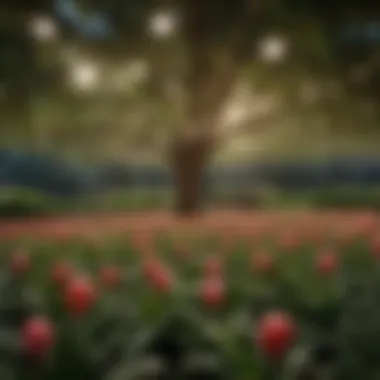

However, a bulb’s durability extends beyond just its lifespan. The environment in which it operates also plays a huge role. For instance, if bulbs are positioned in humid conditions or exposed to fluctuating temperatures, flexibility in design is essential. Look for bulbs made with advanced materials that withstand such conditions without burning out quickly.
Environmental factors such as heat generation also come into play. LED bulbs, thankfully, produce less heat than traditional incandescent bulbs. However, they still require some management, particularly in enclosed spaces. A poorly ventilated area can lead to overheating and ultimately degrade performance.
As you decide on the best bulbs for your gardening setup, factor in:
- Lifespan: How long can the bulb last?
- Material Quality: Is it resistant to humidity and temperature variations?
- Heat Management: Will your setup allow for proper ventilation?
By taking the time to understand lumens and watts, alongside durability and environmental conditions, you can choose the right bulbs that meet your needs for plant growth and energy savings. Keep it simple, but thorough, and your plants just might reward you with an abundance of growth.
Sustainability in Agricultural Practices
Sustainability in agriculture isn't just a buzzword; it’s a critical approach to modern farming that emphasizes the environmental, social, and economic viability of agricultural practices. The use of 5000K LED bulbs highlights this movement effectively. As the agricultural world grapples with the pressing need to minimize its ecological footprint, understanding the role of these lighting solutions becomes paramount. With rising energy costs and environmental concerns, the adoption of sustainable methods is no longer a choice but a necessity for farmers.
Reducing Carbon Footprint
One of the standout benefits of 5000K LED bulbs is their potential to significantly reduce carbon emissions associated with traditional lighting methods. Unlike incandescent bulbs which waste about 90% of energy as heat, LEDs convert more of their energy into light, offering a more efficient solution. This gives farmers the ability to harness artificial light to boost plant growth without exacerbating climate change.
By using these energy-efficient bulbs, farmers can enjoy the following advantages:
- Lower Energy Usage: More efficient bulbs consume less electricity, which translates to lower greenhouse gas emissions over time.
- Longer Lifespan: With a lifespan of up to 25,000 hours or more, LED bulbs reduce the frequency of replacements, thereby diminishing waste. The materials involved in production require a lower resource draw, making them gentler on our planet.
- Reduced Light Pollution: Their focused light emission minimizes unwanted light spillage that can disrupt local ecosystems, particularly during nighttime operations.
"Every little bit helps, and when you add it all up, switching to efficient lighting can have a meaningful impact on a farm's carbon footprint."
Aligning with Organic Farming Principles
The alignment of 5000K LED bulbs with organic farming tenets showcases the broader eco-conscious movement within agricultural practices. Organic farming aims to work in harmony with nature, utilizing methods that promote biodiversity and soil health. The use of LED lighting supports this ethos by minimizing reliance on harmful chemicals often involved in traditional farming setups focused on maximizing yields.
Consider these connections:
- Natural Spectrum: The 5000K spectrum closely mimics natural daylight, which is beneficial for plants, promoting better growth without the need for chemical stimulants.
- Resource Management: Organic farming emphasizes the sustainable use of resources. By incorporating LEDs, farmers can optimize energy use, effectively managing costs without sacrificing productivity.
- Environmental Stewardship: Using technology that supports sustainable growth can attract consumers keen on eco-friendly practices, enhancing market visibility and profitability. This further promotes a positive feedback loop — as sustainability gains traction, so does business viability, adhering to the principles of organic farming.
In summary, the integration of 5000K LED bulbs within agricultural practices not only minimizes environmental impact but also aligns seamlessly with the organic farming principles. By considering both the immediate benefits and the long-term implications of their practices, farmers can foster a more sustainable way to cultivate plants and contribute positively to our planet's future.
Regulatory Standards and Certifications
Navigating the intricate landscape of horticulture requires a keen understanding of regulatory standards and certifications. This concept is crucial when discussing 5000K LED bulbs, as these regulations ensure safety, efficiency, and environmental responsibility. Regulatory standards serve to protect both consumers and the plants they cultivate, providing guidelines that govern the performance, energy consumption, and safety of lighting products.
Certification bodies such as the Energy Star program not only provide a benchmark against which products can be measured but also promote the adoption of energy-efficient technologies. With the agricultural landscape continuously evolving, these certifications are more than just a marketing tool; they represent a commitment to sustainability and quality in horticulture.
Energy Star Certification
Energy Star Certification is a significant badge of honor for any lighting product, including 5000K LED bulbs. This certification program, established by the U.S. Environmental Protection Agency, identifies products that meet stringent energy efficiency guidelines.
For farmers and horticulturists,Energy Star-rated bulbs offer numerous advantages:
- Reduction in energy bills: These bulbs use less electricity than their non-certified counterparts, which can significantly cut operational costs.
- Quality assurance: Products that earn this certification have undergone rigorous testing, ensuring they meet performance and safety standards.
- Environmental impact: Using Energy Star products contributes to lower greenhouse gas emissions, aligning with global sustainability goals.
The certification process requires manufacturers to submit their products for testing and review. The outcome impacts the marketing and distribution strategies, as adherence to these standards can attract environmentally-conscious consumers.
Safety Standards in Agricultural Settings
Safety standards in agricultural settings cannot be understated, especially given the potentially hazardous conditions of farms and greenhouses. Regulatory bodies impose standards to ensure that the installation and operation of 5000K LED bulbs do not compromise the safety of users or plants.
Key aspects of safety standards include:
- Electrical safety: Compliance with standards helps prevent electrical failures that could result in fires or injuries.
- Low heat generation: Unlike traditional bulbs, LED technology inherently generates less heat, reducing the risk of overheating in environments filled with flammable materials.
- Robustness: Many standards, including those set by Underwriters Laboratories (UL), ensure that LED products resist moisture and dust, vital for agricultural settings.
Building a safe working environment is not just about compliance but also about creating a culture of responsibility. When farmers invest in certified energy-efficient lighting, they invest in a safer, more productive future for their farms.
"In a world increasingly focused on sustainable practices, regulatory standards and certifications stand as gatekeepers, guiding the horticulture industry towards a greener future."
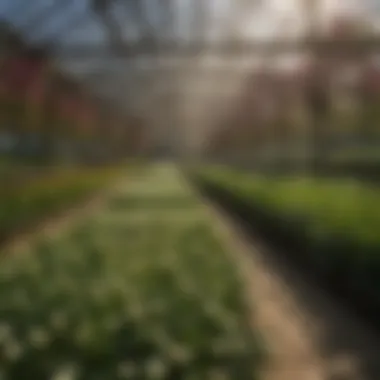

Embracing regulatory standards and certifications is the first step toward ensuring that the use of 5000K LED bulbs contributes positively to both agricultural productivity and environmental sustainability.
Common Challenges and Limitations
When it comes to integrating 5000K LED bulbs into horticulture, it’s not all sunshine and flowers. Recognizing the challenges and limitations is crucial for anyone considering this lighting solution in agricultural practices. While these bulbs boast an array of benefits like energy efficiency and improved plant growth, they also bring with them a set of hurdles that can hinder their full-scale adoption. Addressing these issues head-on is essential for making informed decisions and optimizing the potential of LED technology in farming.
Cost Implications for Initial Investment
Investing in 5000K LED bulbs often requires a substantial initial outlay. While the long-term energy savings can be impressive, the upfront cost remains a sticking point for many farmers and horticulturists. This can be especially challenging for small-scale operations that may already be stretching their budgets thin.
- Price Comparison: LED bulbs are generally more expensive than traditional lighting options such as incandescent or fluorescent lights. The shock of seeing a high price tag can cause hesitation.
- Return on Investment: Farmers must weigh the initial expense against the potential savings in energy bills and bulb lifespans. A solid understanding of how these savings stack up over time is necessary for justifying the price.
- Financing Options: Some choose to explore financing programs or grants designed to support sustainability initiatives in agriculture. Knowing where to look can lead to strategic financial advantages.
Moreover, the cost of installation should also be considered. Some might need to make additional modifications to their existing setups, leading to further costs. As they say, "the devil is in the details."
Heat Generation and Management
Heat generation is another factor that not everyone thinks about when switching to LED technology. While 5000K LED bulbs are known for generating less heat compared to traditional lighting, they still produce some heat, which requires careful management, especially in closed environments like greenhouses.
- Cooling Systems: Depending on the setup, some growers might need to invest in additional cooling methods to mitigate heat accumulation. This leads to increased energy use, which can cut into the savings gained from using LED lights.
- Plant Stress: Excessive heat can stress plants, potentially slowing their growth or affecting their overall health. Understanding how to maintain an optimal temperature is vital for passionate growers.
- Distance from Plants: The distance between the bulbs and the plants also matters. If the bulbs are placed too close, the heat can damage sensitive foliage.
By developing proper heat management strategies, farmers can truly leverage the advantages of 5000K LED technology. With this understanding, they can take the right steps towards maximizing plant health and yield.
It's essential to balance energy efficiency with effective heat management to keep plants thriving.
In summary, while 5000K LED bulbs offer exciting advances in horticulture lighting, their adoption is not without challenges. Financial considerations must be approached with a strategic mindset, and heat management needs to be factored into any lighting plan. With careful planning and awareness of these common pitfalls, the journey into using 5000K LED bulbs can become more manageable and profitable.
Future Trends in LED Technology
As the agricultural sector evolves, so does the technology that bolsters its functions. LED lighting, particularly the 5000K spectrum, plays a pivotal role in this transformation. Understanding future trends in LED technology is crucial for farmers and horticulturists looking to optimize plant growth and energy consumption. The effectiveness of 5000K LED bulbs stems not just from their immediate benefits but also from ongoing advancements that promise to streamline farming operations.
Advancements in Light Spectrum Optimization
One of the most significant trends in LED technology is the optimization of light spectrums to enhance plant growth. Growers have long recognized that different plants require specific wavelengths of light at various stages of their growth. Traditionally, many lights didn’t cater to these precise needs. However, advancements in technology are changing this.
- Customizable LEDs: In recent years, manufacturers have begun developing LEDs that allow for spectrum adjustments. These customizable options enable farmers to fine-tune the light their plants receive based on the growth cycle.
- Broad Spectrum Innovations: New bulbs are being designed to cover a broader range of the light spectrum. This helps ensure that plants receive the necessary red, blue, and green wavelengths all at once, increasing photosynthesis efficiency.
- Research and Development: Ongoing research continues to reveal how specific spectra can be harnessed not just for growth, but also for improving the nutritional quality of produce. For instance, specific wavelengths may enhance flavonoid production in certain fruits and vegetables, making them healthier and potentially more lucrative in the market.
These advancements open a new chapter for horticulture, where nuanced approaches can significantly improve yields and crop quality.
Integration with Smart Farming Solutions
The integration of LED lighting with smart farming technology marks another critical trend. Smart farming, with its reliance on data analytics and automation, allows for better decision-making regarding resource allocation.
- Automation and Control: Modern LED systems can be linked to sensors and controllers. They can adjust light intensity based on real-time conditions in the grow area. For instance, if a sensor detects less sunlight on a cloudy day, it can automatically boost the brightness of the LEDs.
- Data-Driven Insights: With data analytics, farmers can track how different crops respond to varying light conditions. This information can help refine strategies over time, ensuring adjustments are based on empirical evidence rather than guesswork.
- Remote Management: Smart systems can allow growers to manage their lighting from anywhere, utilizing apps or web interfaces. This sort of flexibility is particularly beneficial for large operations, allowing quick changes without making a physical trip to the farm.
"The integration of versatile lighting with data-driven farming methods represents a paradigm shift in agriculture. It enables us to unleash the full potential of our crops while managing resources more efficiently."
In summary, the future of LED technology in horticulture is bright, driven largely by advancements in light spectrum optimization and the integration of smart farming solutions. For those in the agriculture industry, staying abreast of these trends can mean the difference between just keeping up and leading the way. As technology evolves, so too should our approaches to growing, allowing for sustainable practices that ensure the healthy production of food.
Culmination and Final Thoughts
As we wrap up this extensive exploration into 5000K LED bulbs and their significance in horticulture, it's clear that these light sources offer many benefits that can transform agricultural practices both efficiently and sustainably. The shift from traditional lighting methods to LED technology is not just about embracing innovation; it’s about making informed choices that align with the urgent need for sustainability in agricultural production.
The Role of 5000K LED Bulbs in Sustainable Agriculture
5000K LED bulbs stand as a critical component in fostering sustainable agricultural ecosystems. Their capability to promote plant growth while reducing energy consumption makes them a prime choice for modern farming. Key attributes include:
- Energy Savings: Compared to incandescent bulbs, 5000K LED lights consume significantly less electricity, translating to lower utility bills.
- Long Lifespan: With a lifespan that can exceed 25,000 hours, these bulbs minimize waste by reducing the frequency of replacements.
- Targeted Spectrum: Specifically designed to emit a spectrum that aligns with plant needs, these bulbs enhance photosynthesis, aiding in faster and healthier plant growth.
By using 5000K LED bulbs, farmers can integrate eco-friendly practices without skipping a beat on productivity. The lower carbon footprints they generate are essential in today’s climate-conscious landscape.
Encouraging Adoption Among Agricultural Practitioners
While the benefits of 5000K LED technology are clear, the challenge lies in encouraging greater adoption among agricultural practitioners. Educating farmers about the effectiveness of these bulbs in different horticultural settings can spur a more widespread embrace. Here are some strategies that can help facilitate this transition:
- Demonstration Projects: Setting up trial gardens that utilize 5000K LED bulbs to showcase their positive impact can provide tangible proof of their benefits.
- Workshops and Training: Offering workshops to educate farmers not just about the bulbs but about the science behind plant light requirements can empower them to make better lighting decisions.
- Incentive Programs: Government and private sectors can develop financial incentives, such as tax breaks or rebates, for farmers transitioning to energy-efficient lighting systems.
Thus, while the technology holds immense potential, the real challenge lies in taking that leap from awareness to activity. With the right education and resources, the agricultural community can adopt 5000K LED bulbs widely, fostering both improved yields and environmental stewardship.







